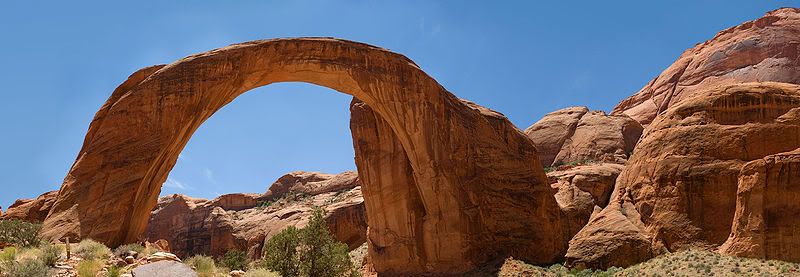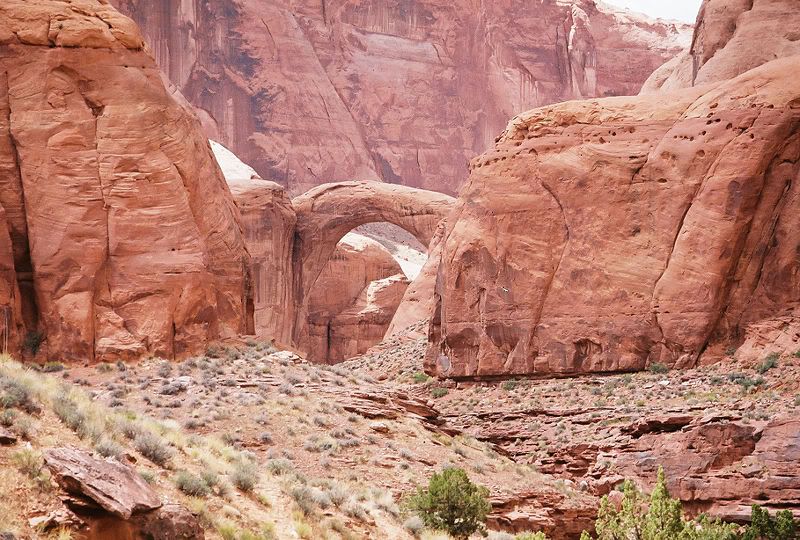During the twentieth century, economic progress in the United States was symbolized by dams. Great dams which tamed the wild waters of the western rivers were seen as a way of providing economic development throughout the region. Supporters often touted the advantages which the electrical power and water storage would bring. Often lost in the cheerleading for dams were the voices of American Indians. Little concern was given to any potential spiritual value of the water and the land. “Dam, baby, dam” seemed to be the mantra echoed by the government.
In this diary, I’m going to look at the damming of the Colorado River and the Indian nations of the Colorado Plateau area.
The Grand Canyon in Arizona was carved out by the Colorado River. This river is dammed below the Grand Canyon by Hoover Dam and it is dammed above the Grand Canyon by the Glen Canyon Dam. Today there are many Indian people – particularly Navajo medicine men – who feel that Glen Canyon Dam should be removed. Unlike many other dams, the Indian concern for the Glen Canyon Dam does not stem from the loss of traditional fishing, or from the flooding of village sites, or from the flooding of graves. The concern is spiritual.
Tucked away among the isolated canyons at the base of Navajo Mountain is a geological feature known as the Rainbow Bridge. For the Indian people of the Southwest – the Navajo, the Hopi, the Paiute – this ancient place is sacred.
In 1910, President William Howard Taft created Rainbow Bridge National Monument to preserve this “extraordinary natural bridge, having an arch which is in form and appearance much like a rainbow, and which is of great scientific interest as an example of eccentric stream erosion.” As a result of this publicity several well-known non-Indians, including Teddy Roosevelt and Zane Gray, made the long trek to see the Rainbow Bridge. While it was designated as a national monument, Rainbow Bridge was isolated and out of the way of tourists. Thus its sacred nature was undisturbed.
Following World War II, tourist traffic to Rainbow Bridge increased as people began to travel up the Colorado River to the area. Still, the fastest way to get to the area – using jet boats – took three days.
The Glen Canyon Dam was authorized by Congress in 1956. The primary purpose of the dam was to store water for the upper-basin states for times of extended drought. In addition, the dam would generate hydroelectric power and its reservoir, named Lake Powell, would provide recreation.
In 1963, the gates on the dam closed and rising Lake Powell began to engulf the river and its side canyons. Higher water made access to Rainbow Bridge much easier, bringing thousands of visitors each year. In order to facilitate the tourists the National Park Service installed a dock in the area.
In 1977 Navajo religious leaders brought suit against federal officials over Rainbow Bridge. The Navajo contended that flooding of the area caused by Glen Canyon Dam and the intrusion of tourists interfered with their religious practices. They asked for a prohibition against beer drinking at Rainbow Bridge and that the Monument be closed during native ceremonies. The district court ruled that their lack of title to the land and the public interest overrides their claims.
In 1978 Congress passed the American Indian Religious Freedom Act which was designed to pro¬tect and preserve traditional religious practices, including access to sacred sites. Many Indian religious leaders thought that this act would give them a voice in the management of the Rainbow Bridge National Monument.
The Navajo continued to pursue their case, known as Badoni v Higginson. In 1980 the Tenth Circuit District Court ruled that low cost electricity created by Glen Canyon Dam and tourism to the Rainbow Bridge was in the public interest and this superseded Navajo religious rights. Furthermore, the Court ruled that accommodating Navajo religious practices would make Rainbow Bridge a shrine managed by the federal government and thus a violation of the First Amendment. With this ruling the court gutted the religious freedom guidelines set forth in the 1978 American Indian Religious Freedom Act.
In 1993 the National Park Service adopted a management plan. As part of the planning process, the National Park Service consulted with the five Native American nations affiliated with Rainbow Bridge: the Navajo, Hopi, San Juan Southern Paiute, Kaibab Paiute, and White Mesa Ute. Chief among their concerns was that Rainbow Bridge – a religious and sacred place – be protected and visited in a respectful manner. Additionally, the tribes expressed concerns about visitors approaching or walking under the bridge. Today, the National Park Service simply asks visitors to visit this site in a manner respectful of its significance to the people who have long held Rainbow Bridge sacred.
In 2000 the Diné (Navajo) Medicine Men’s Association voted unanimously to support the removal of the Glen Canyon Dam and the draining of Lake Powell. The Association points out that the lake has submerged and destroyed many Navajo sacred sites and has interfered with the practice of many traditional ceremonies.
With the Bush administration’s position on energy resources, the Navajo call for the removal of the dam was not well received. Recently, Navajo medicine men tell of being harassed by federal officials for holding religious ceremonies at the Rainbow Bridge.


Leave a Reply